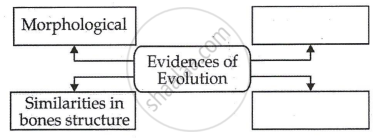Advertisements
Advertisements
Question
Explain any five types of evidence that support the theory of evolution.
Solution
- Morphological evidences: Morphological evidence is based on the similarity of size, shape or structure of organs among a group of organisms proving that they evolved from the same ancestor.
- Anatomical evidences: Anatomical evidence is the evidence of evolution based on the similarities in the anatomical structure of bones and bony joints in the organs of animals.
- Vestigial organs: Vestigial organs are useless organs that are degenerated or underdeveloped due to non-functionality through several years.
- Paleontological evidences: Paleontological evidence of evolution is based on the study of remnants and impressions of organisms that remain preserved underground as fossils.
- Connecting links: Connecting links are some plants or animals that show morphological characters by which they can be related to two different groups of organisms.
- Embryological evidences: Embryological evidence arises from comparative study of embryological developmental stages of various vertebrates. Embryos of different vertebrates appear similar during the initial stages of development and these similarities gradually decrease as the embryo develops.
APPEARS IN
RELATED QUESTIONS
Mammals : _________ : : Amphibia : Fishes
What are vestigial organs?
Explain with an example for the given, how the following provides evidence in favor of evolution in organisms :
Homologous organs
Which of the following pairs of two vegetables represent the correct homologous structures?
(A) Sweet potato and potato
(B) Sweet potato and tomato
(C) Carrot and potato
(D) Radish and carrot
Explain the evolution of giraffe's neck according to Lamarck's theory of evolution.
What are homologous organs?
Select and write analogous structures from the list given below :
1) Wings of butterfly and birds
2) Vertebrate hearts
3) Tendrils of Bougainvillea and Cucurbita
4) Tubers of sweet potato and potato
Wing of an insect and forelimb of a bird are :
(a) analogous organs
(b) analeptic organs
(c) homologous
(d) homophobic organs
One pair of organs in the following animals are not homologous. This is :
(a) forelimbs in humans and lizard
(b) forelimbs in lizard and frog
(c) wings in butterfly and bat
(d) wings in bat and bird
There are five animals A, B, C, D and E. The animal A uses its modified forelimbs for flying. The animal B uses its forelimbs for running whereas the animal C uses its forelimbs for grasping. The animal D can live on land as well as in water and uses its forelimbs to prop up the front end of its body when at rest. The animal E which respires by using spiracles and tracheae uses wings for flying but its wings are analogous to the modified forelimbs of animal A.
(a) What could the animals A, B, C, D and E be?
(b) Why are the forelimbs of animals A, B, C, D called homologous organs?
(c) What does the existence of homologous organs in animals A, B, C and D tell us about their ancestors ?
(d) Why are the modified forelimbs of animal A and the wings of animal E called analogous organs?
(e) State whether animals A and E have a common ancestor or not.
Select a set of homologous organs from the following:
(A) Wings of a bat and wings of a butterfly
(B) Wings of a pigeon and wings of a bat
(C) Wings of a butterfly and wings of a pigeon
(D) Forelimbs of a duck, forelimbs of a cow and forelimbs of a lizard
What do we call the degenerated or partially developed useless organs in living organisms? Enlist such organs in human body? How the same organs are useful in other animals?
Read the following statement and justify same in your own words with the help of suitable example.
There is evidences of fatal science among chordates.
Define fossil.
Differentiate between connecting links and the missing links.
I am a connecting link between reptiles and mammals. Who am I?
Write a short note:
Embryological evidences
Enlist the evidences of evolution.
What is carbon dating?
Which evidence of evolution is shown in the given picture? Explain the importance of this evidence.

Observe the following images and answer the questions.

- Which evolutionary evidences are indicated in the given picture?
- How are they formed?
- Which method is used to measure their age or their time?
Biogenetic law states that ______.
Why do all the gametes formed in human females have an X chromosome?
Homologous organs are:
Evolutionary convergence is the development of:
The study of fossil evidence of evolution is called ______
Organs having similar functions but different origin and development are known as:
What were the characteristics of life forms that had been fossilised?
How do we compute the age of a living tree?
How do we compute the age of a fossil?
While creation and presence of variation is directionless, natural selection is directional as it is in the context of adaptation. Comment.
As shown in figure below some organisms that share a common ancestor have features that have different functions, but similar structures.

These are known as ______. Give example.
Write a note on the significance of Palaeontology.
Industrial melanism was highlighted by ______.
Complete the following conceptual picture:

